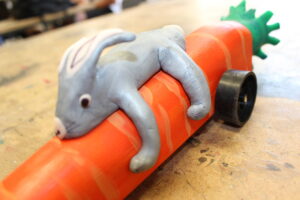I love it when your head and hands need to work together, students need to think and plan on the go, make adjustments, refine ideas and physically create.
Benefits of a Hands-on Learning Approach to Schooling
I am a very proud and biased Design and Technology teacher. In my opinion the “Hands on Subjects” here at Eddies are especially important in today’s growing online society. Whether it is the Arts, Cooking, Music, Design and Technology or anything that you can really get your hands dirty.
I love it when your head and hands need to work together, students need to think and plan on the go, make adjustments, refine ideas and physically create. The skill set our students acquire has so many benefits now and for life after St Edmund’s College.
Hands-on learning subjects in-particular are the acquisition of knowledge, skills and competencies needed in school and the workplace. There are a number of definite benefits that can be comprehended in a hands-on learning environment.
- MORE PROGRAM MATERIAL IS RETAINED
Student experience a huge increase in the amount of information that they retain when given the opportunity to practice what they are learning in the form of hands-on training. Studies have shown that when students sit and listen intently but passively in a lecture-style environment, they retain 20 percent of the presented information. When they are given the opportunity to practice what they have just learned, that percentage increases to 75 percent.
- SIMULATED LEARNING IS AN ENGAGING ENVIRONMENT
When students are given the ability to learn in a practical hands-on environment, they are often engaged, stimulated and want to learn as much as possible. The student’s appetite for learning increases and they are more willing to listen and pay attention if they have a more practical or life like task to complete. Students also become more empowered in their own learning situation.

- A HANDS-ON LEARNING ENVIRONMENT DEVELOPS CRITICAL THINKING SKILLS
A student’s critical thinking skills increase in a hands-on learning environment. This occurs since students must make decisions on what to do next to receive the outcome they are striving to obtain. They no longer have to rely on memory and attention as they sit in a lecture environment. These critical thinking skills remain with a student and are very important to the workplace as every situation that an employee encounters cannot be learned from a book.

- REAL-WORLD EXPERIENCE AND KNOWLEDGE FROM AN INSTRUCTOR CAN GO A LONG WAY
Students who learn in a hands-on environment have teachers nearby who have real-world experience and knowledge and can help and give guidance to them if they have difficulty with a task that they are trying to complete. This expert advice can help them perform the task correctly and safely which is very critical in the workplace.

- USE OF MATERIALS AND EQUIPMENT USED ON THE JOB
One of the benefits of a hands-on learning environment is that students will get a feel for materials and equipment that is commonly used in the workplace after the course. This is particularly good if the student is working with equipment and tools. One of the main reasons for accidents in the workplace comes from equipment and tools misuse; knowing how to properly handle equipment increases safety.

- BUILD RELATIONSHIPS
For many of our students here at Eddies the kitchens, workshops and the performing arts areas are safe spaces for our boys, we have students spending all of their spare time hanging out in their favourite departments. Purely based on their love of the subject and the relationships they have built over time. For our students it is an important skill to know when and who to ask for help, but just as important to take control of their own learning journey and think on their feet. The parent in me absolutely loves that our “Hands On” departments are a place where students can learn the skills for developing a strong and positive mind and body characterised by confidence, responsibility and resilience.

Jason Moore
Head of Design and Technology & Hospitality

